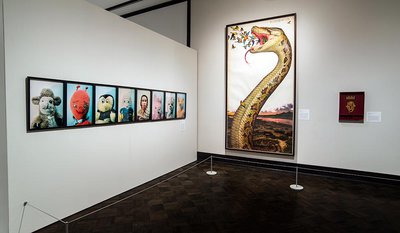
One recent sunny day, my family enjoyed one of our regular trips to the Jordan Schnitzer Museum of Art on the UO campus. It didn’t take long to find some nifty stuff, including a 1981 Basquiat, a 1972 Miró and, be still my heart, a 1963 Giacometti. This isn’t New York City. This is Eugene! And yet here were representative pieces from some of the world’s most beloved artists, on display thanks to the museum’s Masterworks on Loan program, which exhibits art borrowed from private collections.
The program “enhances the scope of what we can show at the museum,” says Jill Hartz, executive director of the JSMA. The loans offer university faculty the opportunity to teach with works not offered in the museum’s collection, while giving the public a chance to see a caliber of art that typically requires a trip to a big city.
Since the JSMA’s curators can’t control what lenders may send their way, the museum staff has focused its efforts on building the visiting masterworks into their educational mission. “The masterworks are used extensively, especially with K-12,” Hartz says. When educators book tours at the museum, JSMA exhibition interpreters often guide students to a discussion around one of the masterwork paintings or sculptures on loan.
The JSMA is one of only a few museums in Oregon that can offer the security, climate control and professionalism necessary for collectors and insurers to consider loaning art. “We have so many offers, more than we can deal with,” Hartz says. “We’re the largest art museum between Portland and San Francisco. To be able to show a van Gogh, a Chagall, a Turner — we feel happy to be able to see it in our state.”
Oregon institutions are ripe with loaned art because ours is one of only five states in the U.S. without a sales tax, making this a tempting first stop for a recently acquired piece of art. Because of complex “use tax” laws, a buyer in some states with sales tax can avoid tax on an art purchase by arranging to exhibit the object in a state like Oregon for a period of 90 to 120 days.
The relationship between the collector and the institution is mutually beneficial, since the loan increases the museum’s scope and visitor draw, while publicly exhibiting the object increases its market value and offers a nice tax incentive for the collector. It’s when one takes a wider view that questions arise, like whether it’s worth the cost to taxpayers in one state to allow a piece of art to be seen briefly by the public in another state.
“Often, works are going from one private collection to another,” Hartz says. Loan programs like the JSMA’s allow the public a chance to view a great work before it recedes into someone’s home or offices.
Sometimes, the JSMA will receive loans from other states without the help of tax incentives. Next year, for example, a collector will loan the JSMA a Morris Graves, to hang beside its companions already in the museum’s collection.
See the masterworks for no cost on Oct. 2, admission is free on home football weekends, and Oct. 3, when admission is free for first Friday.